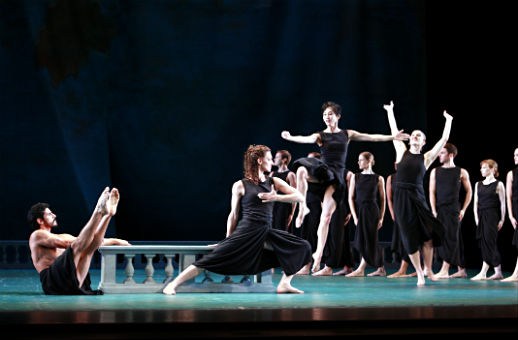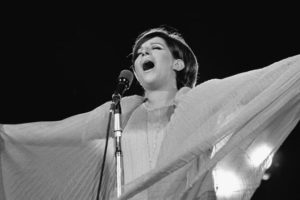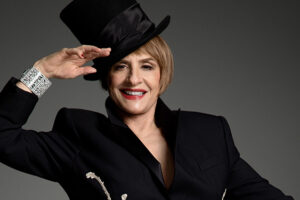

Although I’ve never been an intrepid dance follower, I try to go several times a year, more often to ballet (Balanchine usually) than to modern dance. But Morris is one contemporary choreographer of whose work I have seen a great deal. This isn’t all that surprising perhaps—he’s extraordinarily popular in New York City and his company appears here every year (usually at the Brooklyn Academy of Music which is right across the street from the MMDG studios).
In a fascinating interview with his biographer dance-critic Joan Acocella (one must however try to ignore her stumbling, awkward questioning) focusing primarily on Dido, Morris astutely observes that most (!) of the audiences who regularly attend his company’s performances are music fans rather than dance aficionados.
And although the proportions he proposes are probably exaggerated, I suspect there is a lot of truth in his hypothesis.
For me, if I don’t love (or at least like) the music to which a dance is set, I’m going to have real problems with the work. I remember squirming through an evening by Merce Cunningham’s company; although I really liked the movement, the aggressively assaultive contemporary music turned me off so much that I was a very unhappy audience member. I often have the same problem with 19th century ballet (excepting Tchaikovsky, of course): in the mid-1980s I attended one of Mikhail Baryshnikov’s final appearances in Giselle partnering Alessandra Ferri and found Adolphe Adam’s mindless music such torture that I could barely respond to the dancing.
But I’ve never had that problem with Morris, probably because of his long-standing love of baroque music. In her 1993 biography of Morris, Acocella writes:
The centrality, for him, of emotional involvement with the music is one of the reasons he favors Baroque music. He loves its “clarity of expression,“ as he puts it: “that emotional stuff that just hits you in the face, like an air cushion in a head-on collision.” There the emotion is less direct; he loves the thrill of listening to the music deeply and hearing it give up its secrets. “The more you listen to [Baroque music], the more secret and rich things you can find dramatically. You realize that the phrase lengths are not all the same. You realize that the ways the keys relate changes completely how you feel what’s going on. Within this seemingly very strict form, incredibly dramatic and terrifyingly powerful emotional stuff come out”….In the operas of Handel and Purcell, in the cantatas of Bach, you still have, as Morris appreciatively notes, “dance rhythms and dance tempi—there’s still minuet and gigue and bourée and passepied…The basic thing is still human rhythms.” But the critical thing about these scores, in his mind, is the clarity of their structure. Baroque music, as he says, has “perfect architecture.”
According to the Chronology of Works included in Acocella’s book, during the first twenty years of his career (through 1993) Morris set dances to music by Vivaldi, J.S. Bach, Handel, Purcell, Boccherini, C.P.E. Bach, Couperin, Pergolesi, D. Scarlatti, in addition to Mozart and Haydn. And this remarkable interest continued as Morris moved into directing operas: Rameau’s Platée, Purcell’s King Arthur, and two productions of Gluck’s Orfeo ed Euridice.
His Dido and Aeneas dates from the extraordinary period where for three seasons Morris’s company was invited by Gérard Mortier to take up residence at Brussels’s Théâtre de la Monnaie after Mortier had a bad break-up with Maurice Béjart whose company had long performed there. With the unprecedented resources available to him, Morris (then in his early 30s) was able to create three career-changing full-length works which his company continues to perform more than 20 years later: Dido, The Hard Nut (his deliriously wonderful take on The Nutcracker) and his masterpiece L’Allegro, Il Penseroso ed il Moderato, Handel’s sublime setting of John Milton. Accordingly, Dido and L’Allegro were the first Morris pieces I sought out–both at BAM in 1990–Dido had first arrived in America via Boston the year before, but L’Allegro was making its US premiere—I was immediately hooked!
While Purcell’s eloquent Dido (set to a libretto by Nahum Tate and based on book four of Virgil’s Aeneid) isn’t the first opera in English—that would be probably be John Blow’s Venus and Adonis, but it is certainly the first great opera in the language, as well one of the greatest operas ever written. Even more astonishing is that it tells the same story in less than an hour that takes nearly three hours to tell in Hector Berlioz’s Les Troyens.
In Purcell-Tate’s version, Dido, the widowed founder-queen of Carthage, allows herself to be persuaded by her sister Belinda to accept the attentions of the visiting Trojan prince Aeneas. However, a malignant Sorceress hates the queen so much that she conjures a Spirit (claiming to have been sent by Jove) to appear to Aeneas commanding him to continue on his mission to Italy and found the city of Rome. Stung by his betrayal and to the Sorceress’s delight, Dido kills herself.
Morris admits that he had originally intended to adapt Purcell’s three-act, five-scene gem as a solo work for himself. Eventually realizing the impracticality of that plan, he created the current work where he danced both Dido and the Sorceress, with a male dancer as Aeneas and a female as Belinda and the remainder of the company as both the members of Dido’s court and the witches who conspire with the Sorceress to undo Dido.
I’ve never heard of another production has paired Dido with the Sorceress—the short running time would likely preclude one performer doing both roles, although both lie in the same mezzo range. When the opera premiered in Brussels in 1989, a mezzo sang Dido, while a tenor performed the Sorceress. There is a tradition for casting a man in the role—Christopher Hogwood’s recording has a bass Sorceress, Trevor Pinnock’s a tenor, while William Christie’s first Dido has one of the best Sorceresses ever: countertenor Dominique Visse (who, of course, doesn’t need to transpose it).
At Dido’s first US performances in Boston just months after the premiere, the roles of Dido and the Sorceress were both sung by the same mezzo—the supreme Lorraine Hunt—a tradition that has continued in all subsequent performances of the production and which cannily mirrors his on-stage pairing of the two roles. After Morris gave up the role in 2000, he revived the work in 2006 (when I saw it again at BAM) casting a woman as Dido but a man as the Sorceress. In the Acocella video interview he admits that that was a mistake and he’s returned to having a single dancer do both roles, sometimes a woman, sometimes a man. At Mostly Mozart Wednesday evening, MMDG veteran Amber Star Merkens danced both.
The pairing of Dido and the Sorceress is one of the more provocative features of this interpretation. There is some debate about whether Dido was an actual historical figure, but most versions of her story agree that her rich husband was murdered by her greedy brother Pygmalion and she escaped Tyre, eventually (through a particularly cunning ruse) founding the great city of Carthage. Before she was paired in legend with Aeneas, her suicide was usually depicted as an act of fidelity to her late husband—rather than submit to King Iarbas’s unwanted intention to make her his wife, Dido killed herself.
That overwhelming obligation to her late husband helps make sense of the figure of the Sorceress who then becomes the manifestation of Dido’s wracking guilt about betraying the husband’s memory and submitting to Aeneas’s advances. The Sorceress then is the force of self-sabotage who destroys the relationship assuring Dido’s inevitable self-destruction. For Morris, Dido/the Sorceress is a Janus figure—two faces of the same persona. Little is done to physically differentiate the two women, the dancer simply pulls back her hair as Dido, then lets it down as the Sorceress.
Morris was astonishing when I saw him in the roles in 1990, one of the few times I saw him dance. I don’t remember being distracted by the cross-dressing–he was so compelling that his playing a woman become irrelevant, rather like seeing an onnagata in a Kabuki production. Although Morris can often be quite campy (both on-stage and off-), there was no trace of that in his tortured Dido or malevolent Sorceress.
On Wednesday I was surprised how much Merkens with her striking profile and long curly hair reminded me of Morris, and her tall, androgynous figure didn’t de facto make Dido/the Sorceress necessarily more realistically feminine. Her aggressive Sorceress was particularly delicious, but that she was at least half a head taller than her Aeneas (Domingo Estrada, Jr.) added a poignancy to her reluctant capitulation to love—and to sex, as this production revels in the erotic unlike most other Morris works: Dido and Aeneas rashly couple toward the rear of the stage and the Sorceress briefly masturbates in the fourth scene celebrating her triumph.
As Aeneas, Estrada was also bearded, somewhat unusual to see in a dance performance but this must be part of the role’s iconography for Morris. The first Aeneas was Guillermo Resto, who wore both a beard and dreadlocks and was built more like a wrestler than a modern dancer, particularly striking since Aeneas is the only male character to appear bare-chested—everyone else wears the same thing: a black tank-top and sarong. Resto, a long-time MMDG member, was remarkably arresting in the role in 1990; I later learned that Morris was in love with Resto–despite his being straight–and the pair lived together during the Brussels seasons. Their complex off-stage relationship added an extra layer of ambiguity to the Dido-Aeneas relationship
Estrada was not as commanding as Resto yet was quite touching in his remorse at abandoning Dido.
Morris’s work is sometimes criticized for its “step-to-note style” where the choreography merely “visualizes” the musical notes. While I do understand this criticism, that tendency doesn’t usually bother me; however, seeing this Dido for the third time I was struck by the over-illustrative nature of many gestures which I learned from the Acocella interview are based on American Sign Language. Perhaps because I know Dido so well and have so internalized its libretto, I felt that I was unnecessarily being hit over the head at times, hearing the words sung at the same time they were being “signed” onstage. However, this occasional over-emphasis doesn’t detract from the work’s genuine emotive force.
Unlike the recent Pina Bausch production of Gluck’s Orfeo ed Euridice which the Paris Opera Ballet brought to the Lincoln Center Festival, all of Dido’s solo singers are banished to the pit with the orchestra and chorus. Although Morris didn’t conduct the 2006 revival at BAM, he has since conducted all subsequent performances. Despite the expectation that this is an act of unbridled hubris, he did a very competent job.
With an impressive band made up of many of New York’s best early music instrumentalists and the new head of Juilliard’s Historical Performance program Robert Mealy as concertmaster, Morris led a moderately-paced performance that only got a bit out of sync in a few choral interjections. The balance was a bit off though—the 18-member orchestra seemed a bit under-powered while the 16-member Trinity Choir occasionally sang out too much.
Having found Stephanie Blythe’s more recent Met performances disturbingly driven (particularly the Amneris), I was concerned that she might completely overpower the performance, especially singing with a smallish original-instrument orchestra. However, most of her singing was gratifying nuanced and effective, although she is now more naturally a commanding Sorceress than a vulnerable Dido. Despite all her evident care, the concluding Lament felt strangely unmoving—both Merkens and Blythe lacked the wrenching vulnerability and resignation achieved by Morris and mezzo Jennifer Lane.
Yulia Van Doren’s sprightly Belinda and First Witch were often verbally opaque, and I remain unconvinced she’s the up-and-coming Early Music star others maintain. Joshua Jeremiah was initially rather ungainly as Aeneas but he settled down nicely for his important recitative after the appearance of the Spirit, sung here (unusually) by a tenor.
Mostly Mozart scheduled just four performances of Dido and to judge by the sea of anxious faces awaiting cancellations on Wednesday it could have easily sold several more. Thankfully Dido is that rare Morris work available on video—the other
being The Hard Nut.
Lincoln Center’s long-running summer festival has lately made the MMDG a more regular visitor to Manhattan by mounting L’Allegro and most importantly co-commissioning Mozart Dances in 2006, a major full-length work which can proudly stand alongside those earlier Brussels masterpieces.
The tragic Dido is much with us these days: Les Arts Florissants recently put out its version of Cavalli’s La Didone with the spectacular Anna Bonitatibus on DVD in Europe, with a US release planned for next month. Hasse’s Didone Abbandonata with Valer Barna-Sabadus has been scheduled for CD release by Naxos, possibly as early as this fall. And the Met revives Berlioz’s ever-astonishing Les Troyens in December admittedly with a less-than-optimal cast, but as productions are particularly rare in the US, it’s hard to imagine passing it up.
Photographs by COSTAS.

























Comments